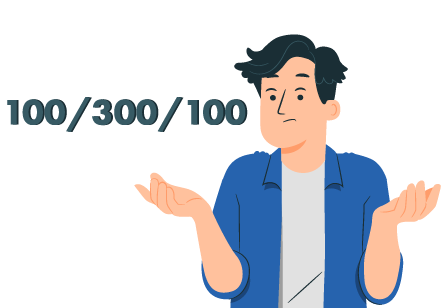When you are shopping for car insurance, you’ll see numbers like 100/300/100. This number refers to liability coverage limits.
100/300/100 insurance coverage is a split limit liability insurance format where each number corresponds to a specific financial limit.
100/300/100 coverage limits are broken down below.
- $100,000 per person for bodily injury liability: This is the most your insurer will pay for one person’s medical bills if you’re at fault in an accident.
- $300,000 per accident for bodily injury liability: No matter how many people are injured, this is the total bodily injury coverage for a single accident.
- $100,000 per accident for property damage liability: This covers damage you cause to someone else’s property such as their car or a fence.
These numbers represent thousands of dollars and are the maximum your insurance will payout. You could be personally responsible for the remainder of the damages if they exceed these policy limits. That’s why choosing coverage that matches how much financial risk you can handle is important.
The 100/300/100 policy offers broad liability protection. It is recommended for drivers who want to protect their assets from lawsuits if they cause a serious car accident. This insurance is also recommended for those with significant income or property to protect.
Before you choose this type of insurance coverage level, look at your budget, your state requirements, and whether the protection against the risks is worth it for you.
What is 100/300/100 Insurance Coverage?
100/300/100 insurance coverage is a split limit liability auto insurance policy that will pay out a lot when you’re at fault in an accident. Each number in this format has a different liability limit in thousands of dollars. This tells you how much the insurance company will pay for bodily injury and property damage per accident.
Bodily Injury Liability Coverage
The first two numbers, 100/300, are the bodily injury liability limits. They consist of per person limit and per accident limit:
- $100,000 bodily injury coverage per person: This is the per-person limit your insurance company will pay for injuries to a single person in an accident you cause.
- $300,000 bodily injury per accident: This is the total your insurance company will pay for all injuries per accident.
Bodily injury liability coverage will pay for medical bills, lost wages, rehab, legal fees, and, in some cases, funeral expenses for the other driver and passengers. But if one person’s medical expenses exceed $100,000, you’ll be responsible for the excess out of pocket.
Property Damage Liability Coverage
The third number, 100, is the property damage liability coverage limit:
- $100,000 per accident: This is the most your insurance company will pay for property damage per accident.
Property damage coverage pays for various damages, including hitting another car, a fence, or a mailbox or damaging public or private structures like mailboxes or lamp posts.
Comparing to State Minimum Insurance Requirements
Most states have minimum liability coverage requirements, which are usually 25/50/25.
These numbers represent the BI and PD coverages listed below.
- $25,000 per person for bodily injury
- $50,000 per accident for bodily injury
- $25,000 for property damage
100/300/100 insurance coverage offers much more than just adequate protection. If you have high-value assets to protect against lawsuits this policy is a good choice.
Limitations and Additional Coverage
100/300/100 insurance doesn’t cover your medical expenses or vehicle damage. To cover those insurance gaps, you can add several types of insurance, such as collision coverage, comprehensive coverage, medical payments coverage, or personal injury protection (PIP) to your car insurance policy.
It also doesn’t cover any damage from an uninsured or underinsured driver. You need to add Uninsured/Underinsured motorist coverage to your policy for that type of insurance.
Choosing 100/300/100 liability coverage gives you peace of mind and more protection against financial disaster, especially in severe at-fault accidents with multiple injuries or significant property damage.
What are the Benefits of 100/300/100 Insurance Coverage?
Choosing 100/300/100 liability auto insurance gives you many practical and financial benefits, especially if you want more protection from the high costs of major at-fault accidents. This liability coverage gives you security and long-term value through potential savings and peace of mind.
- Protection from High-Cost Accidents: One of the biggest advantages of 100/300/100 coverage is that it shields you from big financial liabilities. In a severe accident where bodily injuries or property damage are extensive, the higher limits help cover costs that would exceed minimal coverage limits. For example, a single spinal surgery can cost $100,000 or more, not including rehab or lost income. With healthcare costs rising 670% between 1979 and 2020, even a moderate accident can result in claims far beyond state minimum requirements.
- Reduced Out-of-Pocket Liability: If damages exceed your limits, you’re personally responsible for the difference. Increasing your coverage to 100/300/100 lowers the chance of paying out-of-pocket for excess claims. It helps protect your assets from lawsuits and collections.
- Peace of Mind: Having higher coverage gives you peace of mind, knowing you’re well covered in the event of a major at-fault accident. This is good for drivers who commute in high-traffic areas or carry passengers.
- Potential Discounts and Lower Long-Term Costs: 100/300/100 coverage usually costs more than state minimums, but many insurers offer discounts, often 5% to 10%, for this coverage level. Drivers with good records may see premium reductions over time as insurers consider them lower-risk policyholders.
Choosing 100/300/100 liability coverage is a proactive way to manage risk, preserve financial stability, and ensure sufficient coverage in an expensive healthcare and legal world.
Considerations Before Purchasing 100/300/100 Insurance Coverage
Before buying a 100/300/100 auto insurance policy, you need to evaluate some personal, financial, and car-related factors to ensure this coverage level fits your needs and risk profile. While this type of car insurance policy gives you great protection against big accidents, there are several variables to consider to see if it’s right for you.
Type of Car Insurance Coverage Needed
Start by identifying the types of car insurance coverage that apply to you. 100/300/100 refers to liability coverage, which covers injuries and property damage to others. Still, you may also consider collision and comprehensive coverage for more protection.
Collision insurance covers damage to your car in an accident, while comprehensive covers theft, vandalism, and weather-related damage. If your car is older or worth less than $25,000, you may find full coverage not cost-effective.
Value of Your Car
The value of your car plays a big role in determining the right liability coverage. If your car is worth way less than the liability limits, say under $25,000, you may find high limit liability policy less necessary to protect your car, though still good for liability protection against big injuries.
Healthcare Costs and Accident Risk
The financial risk of even moderate accidents has increased, with healthcare costs rising. For example, a single back surgery can cost up to $100,000, not including ongoing therapy and lost income. In an accident where many people are injured, costs can quickly exceed the minimum liability limits. Higher coverage ensures your insurer covers those costs so you won’t be on the hook out of pocket.
Driving Record and Risk Profile
Your driving record affects both your premiums and your liability risk. A clean driving record will lower your car insurance rates. Still, a history of violations or accidents increases your risk. In that case, 100/300/100 may help offset that risk and give you more protection.
Deductible Preferences
You’re ability to pay out-of-pocket costs should determine your how high you set your deductible. Higher deductibles can save you money in the long run, but you’ll have to pay more out of pocket when filing a claim. Finding a balance between affordability and coverage level is the most important.
Budget and Premium Affordability
More coverage means higher insurance premiums, but make sure the policy fits within your budget. Remember that financial protection from higher limits may be worth an increase in insurance premiums, especially in the event of a major accident.
Insurance Discounts
Many insurers offer auto insurance discounts for good drivers, low mileage, vehicle safety features, and good student discounts. These can help balance the cost of higher liability limits and make comprehensive coverage more affordable.
100/300/100 coverage is a good decision for many drivers, especially those with assets to protect or higher liability exposure. However, you must weigh your personal needs, vehicle value, financial situation, and risk tolerance to make sure you’re getting the right amount coverage without overpaying.
Is 100/300/100 Insurance Coverage Enough for You?
100/300/100 coverage is great for most drivers, but it depends on your financial situation and risk exposure.
For many, these limits, $100,000 per person, $300,000 per accident for bodily injury, and $100,000 for property damage, are enough. But if you have a lot of assets or a high net worth, you may want to consider higher limits or an umbrella policy to protect against lawsuits or damages above your coverage.
Consider your current and future financial obligations. Even without a lot of assets, you could have your wages garnished if you are found liable for excess damages. Many insurers offer coverage up to $500,000 or more for added peace of mind.
For personalized advice talk to an Insurance Navy insurance agent who can evaluate your situation and help you choose the right coverage.
How Much Does 100/300/100 Insurance Cost?
100/300/100 liability auto insurance costs vary by location and driving record but are relatively cheap for coverage. US drivers pay around $1,817 per year on average for this level of coverage, which is only slightly more than 50/100. In many cases, you can double your liability coverage for less than $95 per year, so it’s a cheap upgrade.
Insurance rates vary by state. For example:
- Ohio: 100/300/100 is an average of $463 per year or $38 per month, one of the cheapest states.
- Florida: 100/300/100 is an average of $1,470 per year or $122 per month due to higher risk factors in that state.
Even in the more expensive states, 100/300/100 is cheaper than full coverage, which includes collision and comprehensive insurance. The average Florida full-coverage car insurance policy is $2,802 per year, almost twice the cost of 100/300/100.
Get a Free Car Insurance Quote for Liability Insurance today!
100/300/100 covers you for bodily injury and property damage liability in case of an accident. Before you decide if this is for you, consider the value of your car, your driving record, the deductibles you’re willing to pay, and any discounts you may be eligible for. It’s all about your situation and financial goals.
Ready to get the insurance you need? Contact an Insurance Navy agent today for a free quote and advice.





